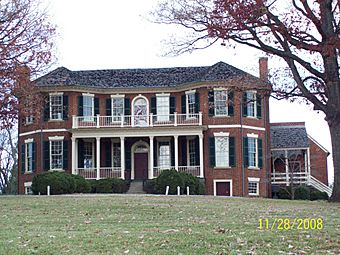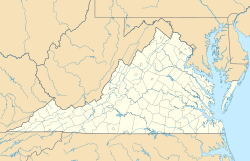Point of Honor facts for kids
|
Point of Honor
|
|

Point of Honor, Lynchburg VA, November 2008
|
|
| Location | 112 Cabell St., Lynchburg, Virginia |
|---|---|
| Area | 4 acres (1.6 ha) |
| Built | 1806 |
| Architectural style | Federal |
| NRHP reference No. | 70000872 |
Quick facts for kids Significant dates |
|
| Added to NRHP | February 26, 1970 |
Point of Honor is an old house in Lynchburg, Virginia that is now a museum. It has amazing views of the city and the James River. People say it got its name because the land was once a secret spot for duels.
Contents
The Story of Point of Honor
Who Built This Historic House?
The person who designed and built Point of Honor was Dr. George Cabell. He was a doctor and a friend of Thomas Jefferson, who later became a U.S. President. Dr. Cabell was also the doctor for Patrick Henry, a famous speaker during the American Revolution.
Before building the house, Dr. Cabell bought a lot of land. This land included three islands in the river. He bought it from Lewellen Jones. Jones had bought it from Christopher Lynch, whose uncle, John Lynch, started the ferry that gave Lynchburg its name.
How the House Changed Hands
Dr. Cabell passed away in 1823 after falling off a horse. His wife passed away three years later. The house then went to William Lewis Cabell. He and his wife, Eliza Daniel, both passed away in 1830.
Eliza's father, Judge William Daniel, then inherited the house. He was a delegate, or representative, in the Virginia government. When he passed away in 1839, the house went to his son, William Daniel Jr. William Daniel Jr. was the father of John Warwick Daniel, who later became a U.S. Senator.
In 1848, David P. Payne bought the house and two acres of land. He sold it back to William Daniel Jr. in 1857. Daniel then sold it to Colonel Robert L. Owen Sr.. Colonel Owen was the president of the Virginia and Tennessee Railroad. His son, Robert Latham Owen Jr., also became a U.S. Senator later on.
Colonel Owen managed the railroad during the American Civil War. After the war, he became a state senator. However, he resigned because he did not agree with combining his railroad with others. Colonel Owen faced financial difficulties and passed away in 1873. The house then changed owners again.
The Langhorne Family Connection
The Langhorne family owned Point of Honor at two different times. Henry Langhorne, who owned mills in Lynchburg, bought the house in 1828. Later, before the Civil War, John S. Langhorne owned it.
John S. Langhorne's oldest son, Chiswell Langhorne, became a very successful businessman. His daughter, Elizabeth Langhorne Lewis, was an important leader in the movement for women's right to vote. John S. Langhorne's granddaughters were also famous. One was Mrs. Charles Dana Gibson, who was the model for the famous Gibson Girl drawings. Another was Nancy Langhorne, who became the first woman elected to the British Parliament in England.
Point of Honor Becomes a Museum
By 1878, L.E. Lichford, a grocery business owner, owned the house. His family owned the property for three generations. During this time, the area around the house grew and developed.
In 1928, James R. Gilliam Jr. bought the house. He then gave it to the City of Lynchburg. The city used part of the property as a recreation center. In 1968, a group called the Historical Foundation received the deed to the house. They worked to restore it.
Architecture and Design
What Does Point of Honor Look Like?
Point of Honor is a two-story house made of brick covered in stucco. It has an interesting shape. The front of the house has a middle section with three window areas. On each side of this middle part, there are sections that are shaped like octagons.
Building the house started in 1806 and finished in 1815. About 20 years later, it was updated. New wallpaper and stucco were added. There might have been a porch added then, but it was removed during a restoration in 1977.
The house looks very similar to the Hancock-Wirt-Caskie House in Richmond, Virginia.
Point of Honor was added to the National Register of Historic Places in 1970. It officially opened as a public museum in 1978.
Historic American Buildings Survey Photographs









